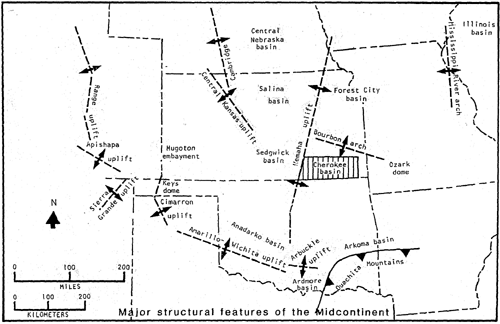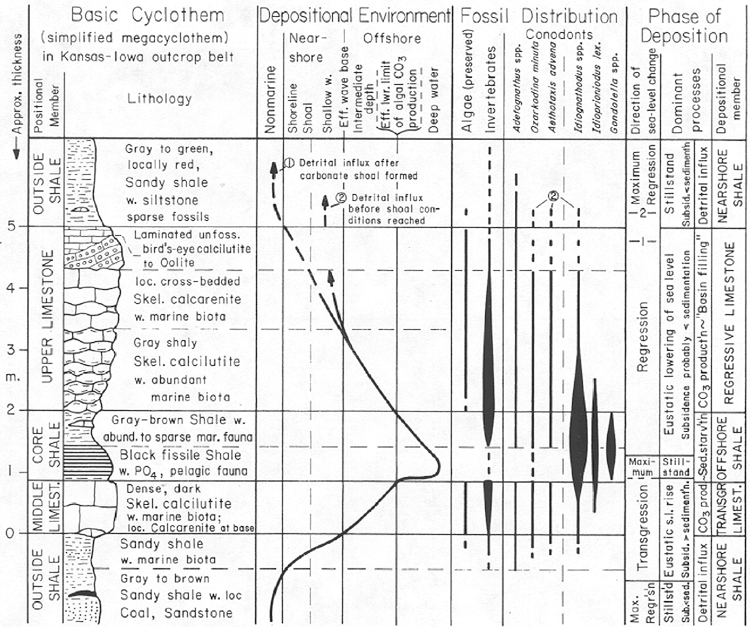 |
|
Kansas Geological Survey Open-file Report 2003-82 |
1.5 Regional Geology
1.5.1 Geological Setting
The Cherokee basin is located on the western flank of the Ozark dome, which is part of the northward extension of the elongated Oklahoma platform (Cole, 1969; Moore, 1979; Figure 1.05). The Cherokee basin is bounded by the Bourbon arch to the north, the Nemaha uplift to the west, and the Ozark dome to the east. During the early to mid-Desmoinesian, the Cherokee basin was influenced by the orogenic activity of the convergent Ouachita system in present-day southeastern Oklahoma (Ham and Wilson, 1967; Harris 1984; Figure 1.05). During the Pennsylvanian, sediment of the Cherokee Group was deposited disconformably upon the karst surface of the Mississippian limestone in southeastern Kansas and adjacent areas (Saueraker, 1966). The Cherokee Group was deposited while the area was part of a slowly subsiding, intracratonic basin (Staton, 1987). Since onset of Cherokee deposition, approximately 4,900 feet (1,500 m) of Pennsylvanian and Permian sediments were deposited in the Cherokee basin (Barker et al., 1992). The Cherokee Group gradually thickens to the south into the deeper Arkoma foreland basin (Gould, 1927; Ham and Wilson, 1967; Jewett, 1951; Figure 1.05). Today, parts of these late Paleozoic deposits are stripped away leaving a homoclinal middle and upper Pennsylvanian succession dipping less than 0.5 degrees to the west (Walton, 1995).
 |
| Figure 1.05 - Location of Cherokee basin and major structural features of the Midcontinent (modified from Wanless, 1969) |
1.5.2 Stratigraphy
In southeastern Kansas, the Cherokee Group (Desmoinesian Stage, Middle Pennsylvanian Series) is divided into the Krebs Formation and the overlying Cabaniss Formation (Jewett et al., 1968; Figure 1.01). It is composed of numerous repetitive successions of interbedded gray to dark gray shale, rippled sandstone and siltstone, underclay, thin coal, and thin argillaceous limestone that have been interpreted as classic megacyclothems (Moore, 1931) and Illinois cyclothems (Wanless, 1931). The Cherokee Group is interpreted as consisting of a number of cyclothems that onlap positive structural features (Ham and Wilson, 1967; Visher et al., 1971, and Rascoe and Adler, 1983). Cherokee Group cyclothems were interpreted as deposited during minor progradational pulses of sedimentation that punctuate a major transgression during the Desmoinesian (Staton, 1987).
A typical Pennsylvanian cyclothem includes beds of nonmarine transitioning to marine sediments in the lower half of the cyclothem, with beds of marine transitioning to nonmarine sediments dominating the upper half of the cyclothem (Heckel, 1977). A transgressive-regressive sequence comprising a typical “Kansas” cyclothem consists of:
- relatively thick, nearshore to terrestrial, sandy “outside” shale, and localized coal;
- thin, transgressive “middle” limestone;
- thin, offshore, nonsandy dark gray to black “core” shale;
- thicker, upward grading regressive “upper” limestone; and
- thick, nearshore to terrestrial, sandy “outside” shale (Heckel, 1977; Figure 1.06).
 |
| Figure 1.06 - The major components of a typical "Kansas" cyclothem and their relation to geologic properties such as depositional environment, fossil distribution, and phase of deposition (from Heckel, 1977). |
e-mail : webadmin@kgs.ku.edu
Last updated January 2004
http://www.kgs.ku.edu/PRS/publication/2003/ofr2003-82/chapter1-5.html